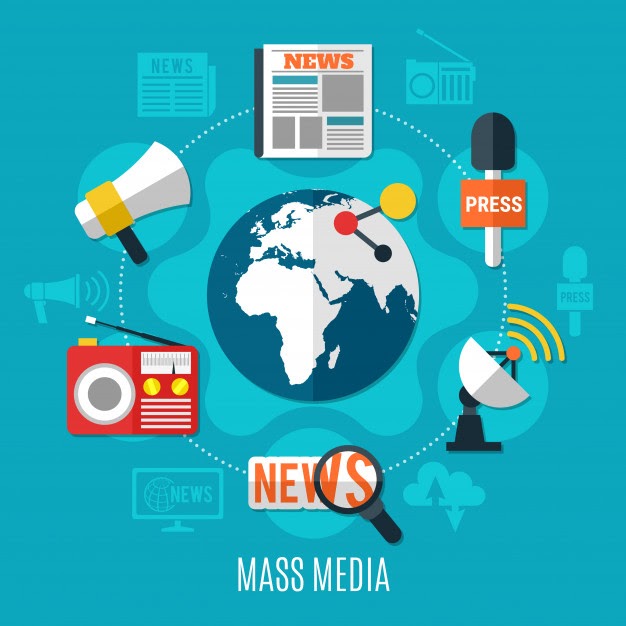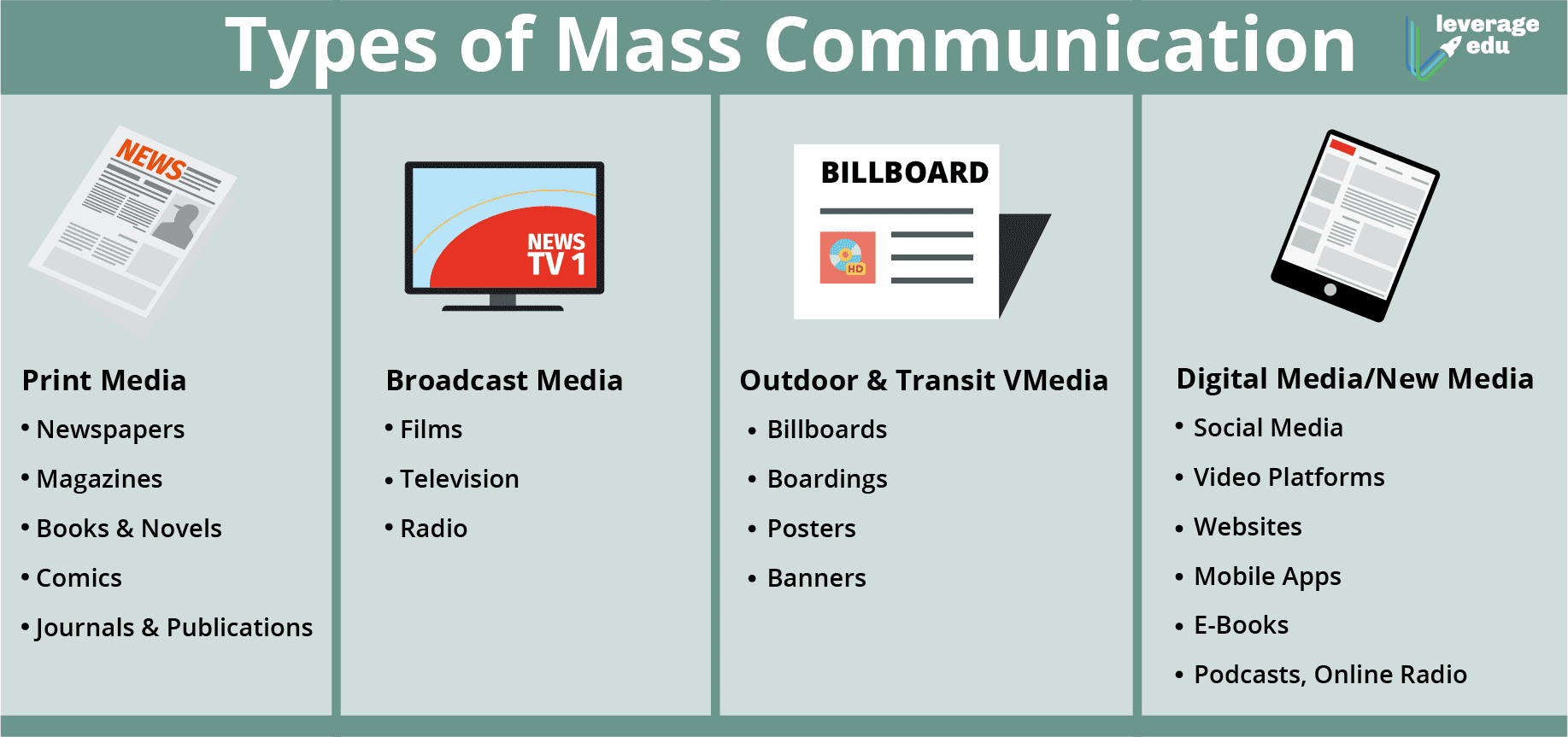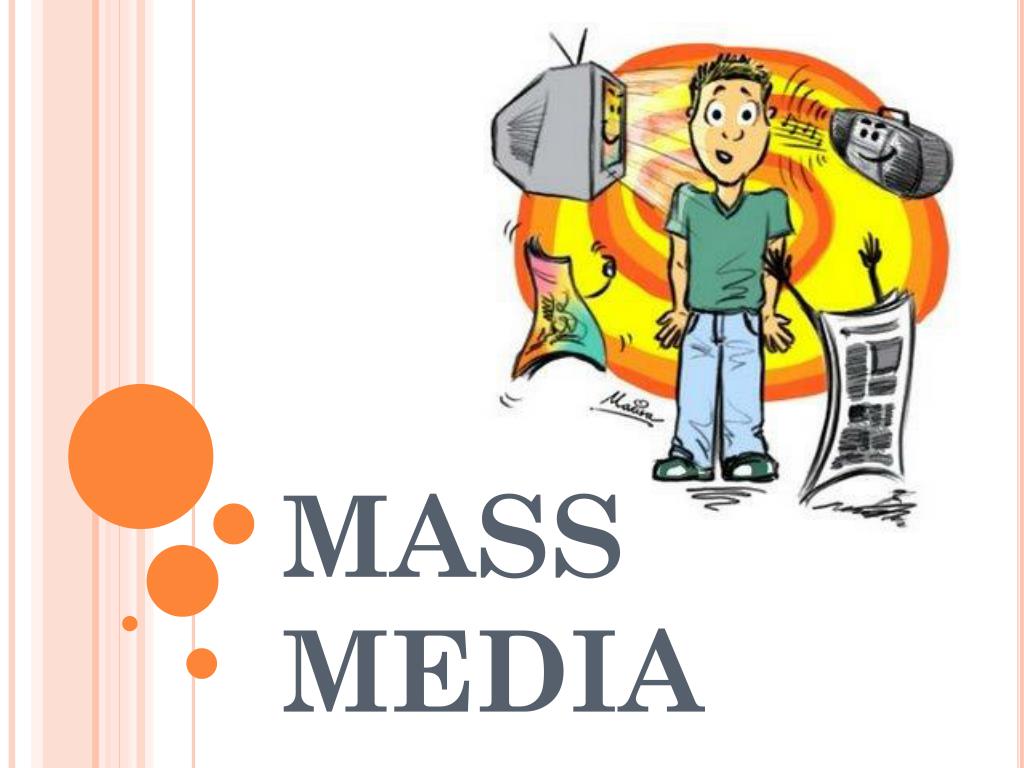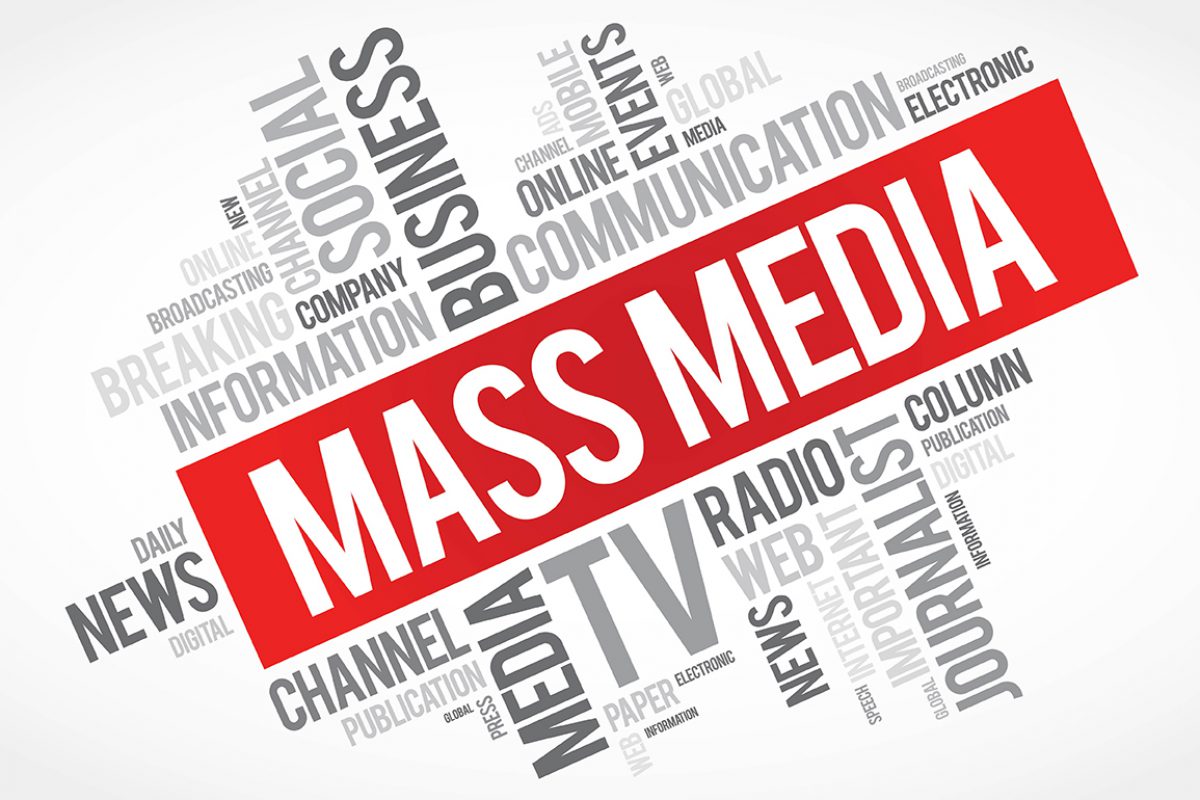For public relations personnel whose job is to disseminate a wide range of information to the public and feed feedback from society to the company’s management, mass media is a reassuring presence as it can reach an unspecified number of consumers.
This time, we will explain the types, roles, and influence of these four major mass media outlets. I would also like to introduce you to web media and social media, which are growing into the fifth mass media, and what advertising is like in mass media.
What is mass media?
Mass media is
a medium that conveys information to the masses
. Specifically, it refers to media such as newspapers, magazines, television, and radio.
Mass media play the role of “mass communication” to convey a variety of information to an unspecified number of consumers, and
are often abbreviated as mass media
. Mass media play multiple roles, including reporting, commentary and enlightenment, education, entertainment, and advertising, and are characterized by their great social influence.
Mass media generally refers to
four media: newspapers, magazines, television, and radio
.
The four major mass media are important in public relations and
PR
activities, and the media to be used depends on the purpose of advertising. With the rise of the Internet, the four major mass media are sometimes referred to as “traditional media,” but they continue to change with the times and their presence remains strong.
Mass media is a communication medium aimed at the “mass” that transmits information to an unspecified number of people, such as tens of thousands to tens of millions of people. Typical examples include television, radio, newspapers, and magazines. Comparing these four, radio provides the most immediate information. Next is television, newspapers, magazines, and books.

Characteristics of the four major media

newspaper
A newspaper is a periodical publication, such as a daily or weekly publication, that provides information of interest to the public, such as news, opinions, and special features. Although it is generally published in paper form, in recent years electronic versions that can be subscribed to on smartphones and tablets, and online distribution that can be read on the web, have become popular.
Newspapers can be broadly classified into general papers and specialized papers. Among general newspapers, they are classified as national newspapers, block newspapers, and local newspapers depending on the area in which they are published. Since the newspapers that are read most often differ depending on the region, public relations personnel should decide which media to approach based on factors such as influence and readership in the region. Specialized newspapers include those that publish information specialized in a specific field, such as business papers, sports papers, and trade papers. There is also a wide variety of newspapers, including official newspapers and Braille newspapers.
The first characteristic of newspapers is their closeness to the local community. Local newspapers have tremendous support locally, and in some prefectures more people read local newspapers than national newspapers. National newspapers also have several pages of local sections.
The second feature is the high level of sharability. It makes it easy to share purchased newspapers with multiple people, such as reading them around or posting clippings. The third feature is that it can be purchased at a low price. It is possible to check the previous day’s news in detail the next morning, and the price is low, making it a medium with high cost performance for consumers.
Japan is one of the world’s leading newspaper countries, and is a country where newspapers are highly trusted. Although the speed of transmission is slower than that of radio wave media such as television, the social responsibility of newspaper companies is significant and the influence of their articles is tremendous. It is a media with a high level of social trust and can reach various reader groups such as general newspapers, economic newspapers, local newspapers, and specialized newspapers. Advertising can improve your credibility as a company. Although circulation is decreasing due to the spread of the Internet, we have strengthened our support for smartphones and the number of digital subscriptions, including electronic versions, continues to increase year by year.
merit
- Advertising is highly reliable as it is a medium that is evaluated as having high social credibility.
- Since the time from manuscript deadline to publication is short, you can place advertisements in a timely manner.
Disadvantages
- Newspapers are published every day, so they become difficult to read after a day.
- An increasing number of households do not buy newspapers, and the number of subscribers is decreasing.
Newspaper subscription rates increase with age. More than 20% of people in their 40s subscribe, and more than 40% of people in their 50s subscribe. It can be said to be
an effective medium when targeting seniors
.

magazine
A magazine is a periodical publication that bears a specific name and publishes a variety of articles. Weekly and monthly publications are the mainstream, but biweekly and quarterly publications are also available. There are a wide variety of categories, including general magazines, specialized magazines (literary magazines, business magazines, etc.), entertainment magazines (fashion magazines, manga magazines, sports magazines, etc.), educational magazines, magazines of various organizations, personal magazines, public relations magazines, etc. There is.
Depending on the subscription level, magazines can be divided into general magazines, men’s magazines, women’s magazines, teens magazines, etc. Public relations staff should change the magazine media they should approach depending on the preferences and interests of the consumers they wish to communicate information to.
Magazines are often sold at bookstores and convenience stores, but like the newspapers mentioned above, it is also becoming popular to sell them as e-books on smartphones and tablets.
One of the characteristics of magazines is that they appeal to the five senses, which is unique to paper media. Editors consider the texture of the paper used for each medium, and the impression that readers receive differs depending on the texture and printing technique. It is a medium that can leave a strong impression on the reader’s eyes with its vivid visuals.
It is a print media that specializes in genres sought after by readers, such as fashion, hobbies, and finance, and is characterized by its high readability. Since the target is clear, you can reach them efficiently. There are various types of magazines, such as weekly, monthly, and quarterly magazines, and in recent years, the publication of free newspapers has become more prominent. Like newspapers, online magazines are becoming more popular as they are increasingly compatible with smartphones using e-book readers and viewing apps, and can significantly reduce the costs of printing, binding, and stocking.
merit
- Magazines are segmented by reader age, gender, hobbies, etc., making it easy to narrow down your target audience.
- Since it has a high shelf life and can be expected to be read repeatedly, the exposure period for advertisements is long.
Disadvantages
- It takes a long time from the manuscript deadline to publication.
- It is difficult to discover potential customers because the target is narrowed down to each magazine from the beginning.
Of the four major mass media, it is the easiest to target. Additionally, it is thought that people who pick up magazines are highly motivated to obtain information about specific genres such as fashion and sports, so
it is possible to precisely appeal to highly sensitive readers
.

tv set
Television is a technology that uses radio waves to transmit images to remote locations and reproduce the images on a receiver. Alternatively, it often refers to the equipment used for that purpose, especially television video equipment.
Television broadcasting stations include public broadcasting and commercial broadcasting.
Types of TV programs include news programs, entertainment programs, documentaries, wide shows, and educational programs (children’s programs, language programs, etc.).
The main difference from the other four major media is that information can be conveyed through video and audio, and because it has a large audience, the impact of broadcasting is large. Not only is the news up-to-date, you can get information in the form of videos, and there are no viewing fees for commercial broadcasts. Local stations also have many programs that are closely related to the local area.
In recent years, with the rise of video distribution services, there has been talk of a decline in TV viewership, but portal sites such as TVer and Paravi have also established systems that allow viewers to watch programs at any location and time. It can be said that television remains a highly influential medium.
Television is the most popular of the four major mass media. Because the transmission speed is fast and facts can be conveyed objectively through video, you can reach a huge number of people in a short period of time. It is effective in increasing a company’s brand loyalty. Recently, smart TVs that can connect to the Internet have become popular, and their potential as a medium is expanding, allowing them to participate in programs in real time.
merit
- Can be widely announced and made known to many people
- A highly influential medium that makes it easy to convey your brand image
- Images and audio are easy to remember and are easy to remember.
- It becomes a big topic depending on the content of the commercial and the talent used.
Disadvantages
- CM production and broadcast costs are high
- It takes time and effort from commercial production to airing.
- When watching recorded programs, commercials tend to be skipped
Many people may associate advertising with TV commercials. 90% of Japanese people watch TV, and it is a medium with excellent advertising power. This is
the perfect medium if you want to let people know about your company’s services or convey your image
. However, due to the high cost, I hear that some people would like to try it but cannot afford it.
radio
Radio is an audio broadcast of news, music, etc. sent from a broadcasting station using radio waves. Because information can be obtained in real time in audio format, many listeners enjoy the program while doing other tasks such as driving, studying, or cooking. Another unique feature of radio is that it allows for two-way communication between the personality and the listener.
It also has a high level of breaking news and is excellent at disseminating traffic information, general news, and information in the event of a disaster. Compared to television, the transmission system has a simpler structure, making it easier to continue broadcasting even in the event of a disaster.Radio allows information to be transmitted even in situations where television cannot be watched due to a power outage.
In recent years, the Internet distribution service radiko has been aiming to reach younger people and increase its spread on SNS, and a system has been built to distribute the content of local stations nationwide.
Because it is an audio-only broadcast and has limited radio wave coverage, it is a highly regional medium. It is also called “personal media” because of the close relationship with the listener. Although it has less reach and appeal than television, it has the advantage of being low cost. Targets are fixed by time zone, region, and genre, so information can be delivered to pinpoint locations efficiently. Its value as a “media” that can be listened to while doing housework or work is being reconsidered.
merit
- Easy to target according to the listener group of the program
- CM production and broadcasting costs can be kept low.
- CMs are rarely skipped
Disadvantages
- I tend to listen while doing other things, so my ability to concentrate on commercials is low.
- Sometimes it is not possible to convey the image with just voice.
Another characteristic of radio is that it is often listened to while driving. You might consider targeting your appeal to business people who are commuting to work or working in their cars.

Should the Internet and SNS be included in mass media?
So far, we have explained the four major media: newspapers, magazines, television, and radio. So, are the rapidly developing Internet and SNS included in mass media? In this section, we will explain the media on the Internet, which can now be called social infrastructure.
Online media can be broadly classified into two categories: web media and social media. Web media refers to websites that transmit some kind of information on the Internet, and specifically includes news sites, curation sites, corporate sites, etc.
Social media refers to media that includes social elements such as information transmission by individuals and connections between individuals. Specifically, this includes Twitter, Instagram, Facebook, YouTube, TikTok, Niconico Douga, etc.
Web media and social media, which use the Internet as their main battlefield, already have an influence comparable to that of mass media, and are becoming the fifth mass media.
According to the “Advertising Expenditures in Japan in 2020-2015” announced by Dentsu in February 2020,
Internet advertising expenses were 2.229 trillion yen, a market size comparable to the 2.2536 trillion yen spent on advertising in the four media.
It became.
Web media and social media on the Internet are characterized by their high dissemination. It also has excellent reporting speed, and its strength is that you can instantly search for the information you are looking for from a huge amount of information. On the other hand, it has the disadvantage that misinformation and fake news can be circulated because individuals can easily disseminate information, but their
presence is increasing year by year
.

Characteristics of Internet media
primary media
They have the characteristic of being a source of information, and newspapers, news agencies, television, etc. fall under the category of primary media. Refers to media operated by editors or writers with editing functions. It has a strong impression of being a public information source, and the number of page views is relatively large, so its advertising is highly reliable. There is a wide range of people that can be reached with advertising, and the key point is that you can choose by genre.
owned media
Media that is operated by a company and includes not only corporate sites but also blogs, Facebook, etc. The advantage of running owned media advertising is that you can directly contact users who are likely to support your company or product. Another advantage is that since it is our own media, there are no real advertising costs.
secondary media
Portal sites such as Yahoo! News are called secondary media, and are characterized by the secondary publication of news distributed by primary media. It has the advantage of being viewed by far the most among Internet media, and can reach a large number of users regardless of gender, age, or preference.

Advantages of social media as an advertising medium
blog
A blog is something that individuals, corporations, groups, etc. write about such things as diaries, opinions, editorials, and the latest information. Blog ads are generally banner ads that can be posted on blog pages, and some blogs have their own ad space, such as Ameba, and some ads are built into part of an ad network and are automatically posted. It has the advantage of being able to reach user groups with various attributes and being inexpensive to start with.
SNS (Facebook, mixi, etc.)
Examples of SNS sites include Facebook and mixi. The purpose is to connect people, send and receive messages, and communicate through photos and videos. Among them, Facebook is considered the world’s largest SNS, with over 26 million users in Japan. The feature is that you can advertise products and your own page for Facebook users, and you can set detailed targeting. Since you can reach a variety of user groups, efficient advertising operations are possible.
Twitter, Instagram, etc.
Twitter and Instagram also fall under the category of SNS sites, but compared to Facebook and other sites, their main purpose is not to connect people or organizations, but to spread information. Among them, Twitter is one of the most famous SNS in the world, and as an advertising medium, it is effective not only for increasing awareness but also for quickly communicating the content you want to promote to many users. It is also possible to discover potential customers that you have not targeted before.
video media
Video sharing media is represented by YouTube, NicoNico Douga, etc. It is an advertising medium that uses video like TV commercials, and can be linked to TV commercials and reach groups that cannot be reached with commercials. The size of the market as an advertising medium continues to expand, with many cases of it being used for corporate branding.

What is the influence of mass media?
Mass media that conveys information to an unspecified number of people. What kind of impact does it have on the world? This time, I will explain it from three perspectives: “impact on politics”, “impact on economy”, and “impact on culture and education”.
Impact on politics
When the mass media reports and explains political facts, citizens obtain information and use it as a basis for making decisions about political topics. The image given by media reports such as newspaper headlines and news captions, and the opinions of commentators appearing on wide shows, etc. each have an impact on the formation of public opinion. Its influence is so great that it is sometimes referred to as the “fourth power,” along with the legislative, judicial, and executive powers.
Economic impact
Information flowing from mass media has a huge impact on people’s economic activities. Information about products and services that we see in the mass media may be advertisements posted by companies, or may be the result of public relations activities.
Examples of advertising include television commercials, magazine ad pages, newspaper ad sections, and radio commercials. They are frequently and repeatedly encountered in daily life and leave a strong impression on consumers.
Examples of public relations activities include a company or product being introduced on a news program or variety show, or the president appearing on a documentary program.
When a specific event is covered multiple times in the mass media, a common understanding is created that “this is popular”, which leads to economic effects. Easy-to-understand examples include people flocking to spots featured on TV or in magazines, or products being sold out.
Influence as culture and education
As mentioned earlier, mass media has the “teacher’s function,” or the role of passing on values and knowledge to the next generation. Television programs include language learning programs, educational programs for children, and hobby programs such as sign language and shogi. There are specialized magazines (newspapers are specialized papers) of various genres, and they have an impact on creating the foundation for culture and education.
Furthermore, mass media has a great significance as entertainment. Specifically, these include movies, dramas, sports broadcasts, programs that provide entertainment information for enjoying leisure and leisure, and variety programs that focus on talk and comedy. These entertainment contents establish popular culture that is widely enjoyed by people, and create trends by establishing the popularity of certain subjects.

What is the future of mass media?
The word “mass” means “the masses,” and for a long time information was driven by mass media such as television, newspapers, and transportation advertisements, and the Internet entered the market from around 2000.
After nearly 20 years, in 2019, online advertising overtook the TV commercial market and widened the gap, so it can be said that
the internet is becoming a mass media
.
Furthermore, even during the coronavirus pandemic, online advertising saw a slight increase while offline media saw a year-on-year decline.
Given the current situation where companies are clamoring for a digital shift and advertising investments are also moving online, online advertising is likely to increase or at worst slightly decrease in 2021 even with the impact of the coronavirus.
Compared to the four mass advertising media, Internet advertising is growing steadily, as can be seen from the graph below from the aforementioned “Advertising Expenditures in Japan” survey.
Internet advertising is not in the position of a challenger, but is already in the position of the strong. If we do not proceed with this premise in the future, we will not be able to understand why laws and regulations are being strengthened, so it is important to understand this clearly.

summary
So far, we have looked at the types of media, the characteristics of advertising, and their benefits. It is important to note that the types and styles of advertisements that can be posted differ depending on the media, and the demographics that can be reached also differ. Be sure to understand the characteristics of each advertising medium and choose the most suitable one.


